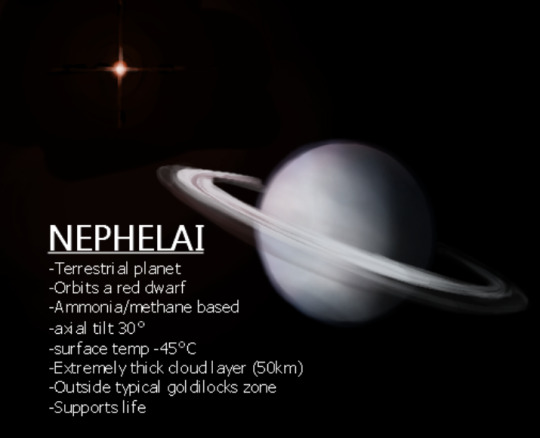#This setup is so improbable but so is Earth. life supporting planets be like that
Explore tagged Tumblr posts
Text

Nephelai is the setting of my speculative biology project, and a very weird planet.
The best way I can describe it is that it’s a cold venus. Its atmosphere is mostly composed of ammonia, methane, and nitrogen in copious amounts, resulting in a powerful greenhouse effect that warms the planet despite its distance from its low-heat star. The resulting cloud cover also blocks all light from reaching the surface.
Cloud formation is spurred by temperature gradients between layers of the atmosphere, which help insulate the planet and promote even more temperature difference. The intense polarization results incredibly frequent, violent storms, which happen to also be the main energy source for surface-bound life.
That’s right, life on Nephelai is electricity based! The combination of cold temperatures, reliable electricity sources, and ammonia-based physiology make this method of metabolism more efficient than typical chemical metabolism, at least for macroorganisms. Energy is gathered and exchanged through raw currents rather than molecular vectors, though organisms do still need to eat to keep their physical cells intact. The line between consumer and producer is blurred here, with many fascinating combinations of both lifestyles.
Anyway here’s a medley of surface organisms, described from left to right. Absolutely not an exhaustive list.

Figure 1: A species of tree analogue. Basically a living lightning rod. Prolific across the planet, and extremely important for all ecosystems they’re in. Owners of the largest battery organs on the planet, which they use to survive for years at a time without storms.
Figure 2: a mobile tree analogue! Part of a whole niche known as ‘stormchasers’, organisms that follow the wake of thunderstorms to harvest energy. Gigantism is common in this niche for the same reason it’s common in the deep sea. Inhabits the plains of the equator’s hurricane band.
Figure 3: Another stormchaser, this one smaller but faster. The ‘head’ is a purely sensory bulb, with the brain being inside the main body. Eats other organisms for the material aspect of its diet.
Figure 4: Mid-sized predator. Uses bioluminescent spots on its knees to hunt by sight, but is overall more of a hearing-based hunter. Their taxonomic class has no external tail-rod, and instead drains using conductive ‘fangs’ in its mouth.
Figure 5: Kyliyts. One of two sophont species. Cosmopolitan, flying pack-hunters that’re allergic to making permanent settlements. Live in inseperable groups of siblings called flocks.
Figure 6: Tipoon. The other sophont species. Rat-sized, very gregarious scavengers/ambush hunters that live in communities of high population density. In the same taxonomic class as Figure 3.
#SPECBIO JUMPSCARE#it's about time i subject all my rainworld followers to more of my mad science#kyliyts#nephelai#speculative biology#spec bio#xenobiology#art#This setup is so improbable but so is Earth. life supporting planets be like that#OH RIGHT ALSO#long post
148 notes
·
View notes